1 November 2016
Buckley Street, Essendon – making Melbourne's roads and rail safer, and less congested
The Victorian Government is removing 50 dangerous and congested level crossings, including at Buckley Street, Essendon.
Removing the level crossing at Buckley Street, will improve safety, reduce congestion and provide the opportunity to transform the local precinct.
Currently, these boom gates are down for an average of 78 minutes between 7am and 9am on weekdays.
The Level Crossing Removal Project (LXRP) have investigated a number of design options to remove the level crossing and have identified a preferred option (option 1 below).
The project has been working with key stakeholders, including Moonee Valley City Council, Public Transport Victoria, and local traders.
Now we're asking the broader community to provide feedback on the project designs and how we can transform and renew the surrounding area.
While you wait
- More than 15,000 vehicles cross Buckley Street level crossing each day.
- Boom gates are down for an average of 78 minutes in the weekday peak between 7am and 9am.
- More than 30,000 train passengers use Essendon station every week.
- An average of 190 trains travel this line each day.
Understanding the local area
When removing the Buckley Street level crossing, we have the opportunity to improve the local precinct and renew the area.
We want to fully understand how each design option will benefit or impact the area. To do this we want the local community and people travelling through the area to share with us what is important to them.
Local schools and traders
In October 2016, we began speaking with local schools to better understand how students access their school.
Understanding the way students, customers and parents move through the area at different times of the day allows us to integrate feedback into the design and ensure that traffic is not only reduced, but passes through the area as efficiently and safely as possible.
Heritage
Essendon Railway Station is considered to be the most representative example of the Federation Free style designed train stations which was constructed between 1909 and 1922, and demonstrates the expansion of Melbourne and settlement of the suburbs early in the 1900s.
While LXRP will preserve the station as part of this project, we will investigate opportunities to improve its facilities, the way the station is accessed and how it interfaces with other transport, including bus services and tram route 59.
The Essendon Railway Station Complex is listed on the Victorian Heritage Register due to its architectural, aesthetic, social and historical significance to the State of Victoria.
Movement around the area
LXRP has undertaken studies to identify how pedestrians, cyclists and vehicles use the area.
The studies showed:
- the level crossing carries 15,000 vehicles per day
- there are 10 different bus services that connect with Essendon Station
- approximately 2000 people a day connect with Essendon Station by bus
- approximately 1600 people a day connect with Essendon Station by car
- approximately 800 people a day connect with Essendon Station by tram
- many local streets will experience lower traffic volumes as drivers will no longer avoid the boom gates after their removal, also leading to improved travel times into the CBD.
Improving the local area
As part of the project, we are identifying opportunities to enhance the surrounding area.
These development opportunities will revitalise the precinct and provide significant economic and social benefits to the wider community.
We will provide better connections to assist with possible developments that could include:
- cafes or wine bars
- residential developments
- retail opportunities
- open spaces.
We want to hear more from the community about how locals use the Buckley Street precinct and how we can revitalise this area for retail and residential growth.
Project benefits
The Buckley Street Level Crossing Removal Project will deliver significant benefits to those who live and travel along the Craigieburn Line.
Improved safety
Pedestrians and cyclists will no longer have to cross the busy and congested Buckley Street to get to and from Essendon Station, including many students at local schools.
Boosting the economy
By creating hundreds of jobs during construction, and improving opportunities for local traders.
Better connected communities
By removing the level crossing and providing opportunities for better travel, we will create better access to local shopping areas and schools.
Improved travel times
By allowing major east-west connections for people coming from Keilor, vehicle movements will be improved through the area by diverting traffic from local streets.
Please tell us what's important to you – have we missed anything?
Understanding the different options
There are a number of factors to consider when selecting a design for a level crossing removal.
The most common ways to remove a crossing include:
- lowering the rail line under the road (rail under road)
- building a rail bridge over the road (rail over road)
- lowering the road under the rail line (road under rail)
- building a road bridge over the rail (road over rail).
Other options include realigning roads and crossing points to improve traffic flow and local connections, and partially lowering the road and raising the rail line, known as a hybrid solution.
There are many examples of these designs across Melbourne, and all over the world.
We will continue to undertake a range of assessments to remove the level crossing, including:
- traffic, pedestrian and cyclist studies
- precinct studies
- geotechnical investigations
- hydrology assessments
- utilities investigations
- environmental studies
- flora and fauna investigations
- disability and access compliance
- cultural and European heritage investigations.
Options ruled out
Rail bridge over existing road
This option has been ruled out due to a mix of challenges, including extensive land acquisition and the major work that would be required on the railway at Park Street and Mount Alexander Road.
Road bridge over existing rail
This would require constructing a large Buckley Street road bridge over the existing rail line and has also been ruled out, due to technical constraints.
Due to the hilly nature of Buckley Street, this solution would require the construction of a large bridge structure along Buckley Street. This would make connections complicated and potentially unsafe at Mount Alexander Road, and also create significant visual issues along Buckley Street.
Why no tunnel option?
The project team has not pursued a tunnel solution, as the rail track can only incline and decline on a gradient of 2% (meaning on a 100m length of track, it can only be raised or lowered by 2m).
Considering this option would require a long tunnel entrance on a gentle slope. This would require substantial property acquisition at the tunnel entrance and exit.
Appropriate ventilation requirements along the tunnel can be intrusive in residential areas. From a construction perspective, such works could take up to 5 years.
Also, the purchasing and manufacturing of custom built tunnelling equipment that is required to undertake the drilling works can take over 12 months to obtain.
Maintaining the third track along Essendon Station
Public Transport Victoria (PTV) are undertaking network rail upgrade works across Melbourne, and as part of these works, they will be upgrading the third track at Essendon Station.
This track will utilise Platform 1, currently not in use. The upgrade work will extend this platform to allow for next-generation trains.
What are the design options for the Buckley Street level crossing?
We have investigated a number of options for removing the Buckley Street level crossing.
While we have not finalised a final solution, based on our current assessments we have a preferred option that avoids private land acquisition, and improves traffic flow through and around the area.
Option 1 (preferred option)
Lowering Buckley Street beneath the existing rail line, with the rail line remaining at its current level.
Benefits:
- no acquisition of private property
- additional lane for local traffic
- opportunity to transform the Essendon Activity Centre and local precinct, creating a connected transport hub and revitalised community area
- no impact to heritage station precinct
- improvements to station facilities and connections
- removes arterial traffic that currently diverts into local streets to avoid the level crossing
minimises rail shutdown times during construction and minimum inconvenience to commuters - safe and local connectivity for traffic and pedestrians
- shortest construction period required, meaning less disruption to the community
- pedestrians and school students will not have to cross a major arterial road.
Challenges:
- some right turns into local streets would be removed
- ability to cross over Buckley Street would be reduced.
We also considered four other options which are detailed below. These options have significant challenges with property acquisition impact to the heritage precinct.
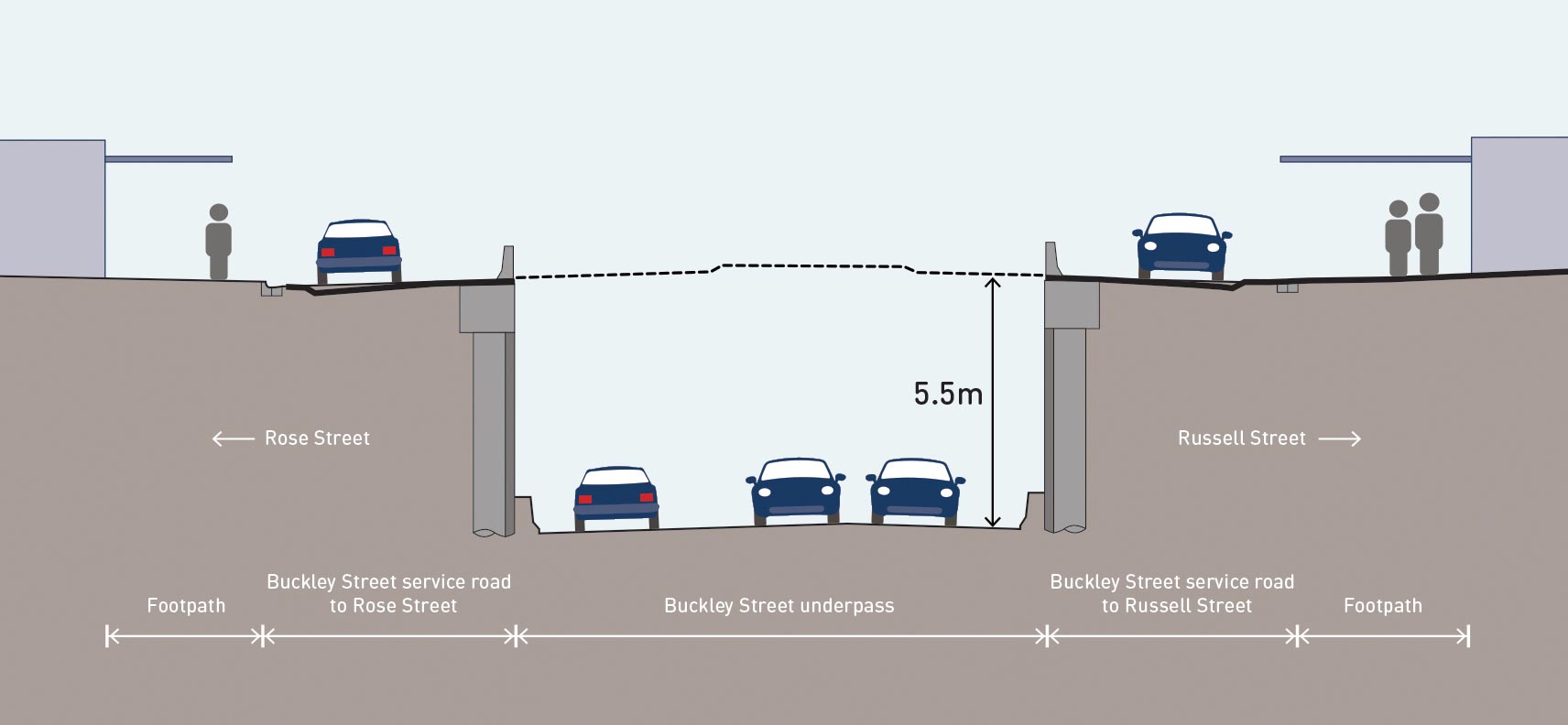
Option 2 (ruled out)
Raising the rail line onto a rail bridge over Buckley Street.
Benefits:
- heritage station precinct would be retained
- Rose Street and Russell Street precincts would remain unchanged
- allows for opportunities to develop public areas under elevated structure.
Challenges:
- extensive private property acquisition required
- visual impact to area
- tree and vegetation removal on Rose Street and Sherbourne Street
- significant impact to heritage properties during construction
- major work required on the railway extending beyond Park Street and Mount Alexander Road
- major disruptions to the community via extended construction timeframes to complete works.
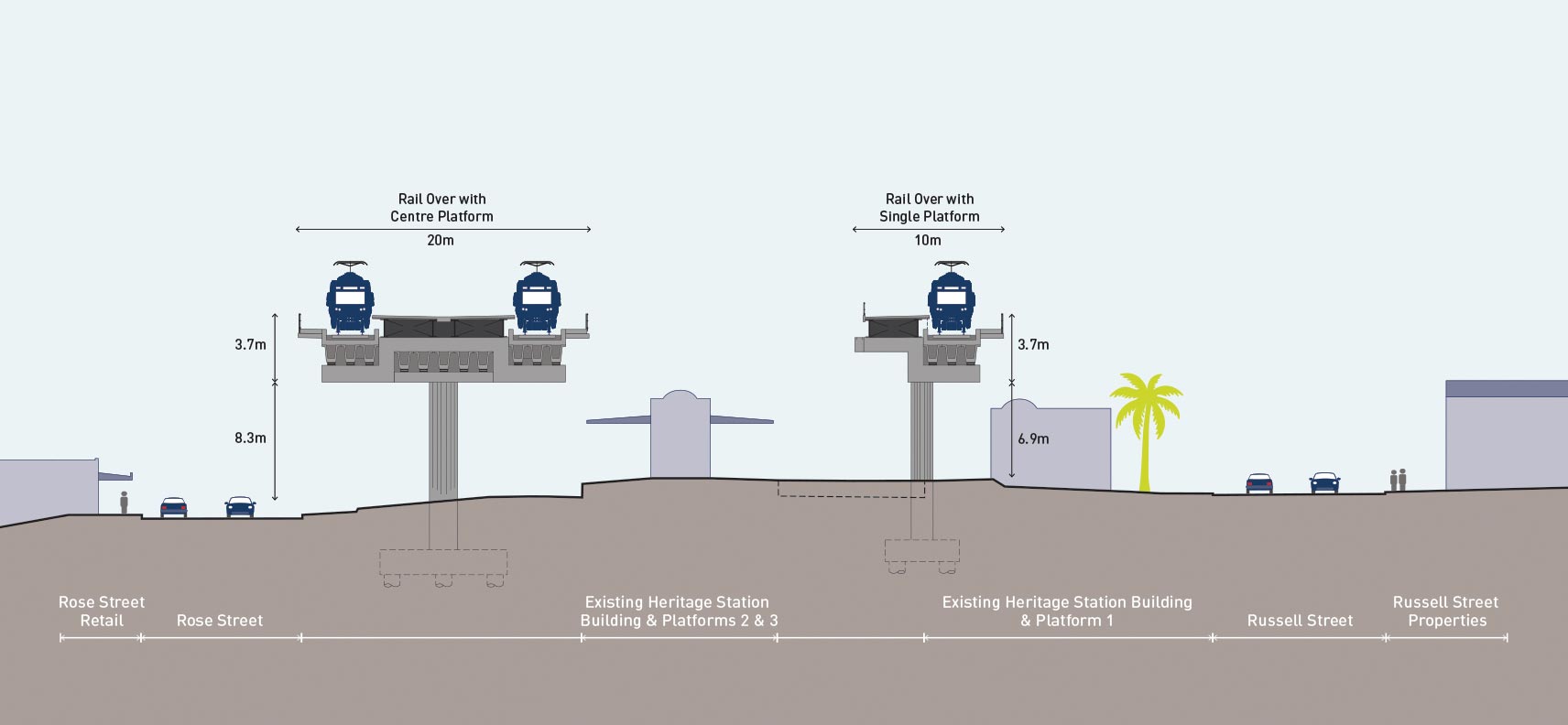
Option 3 (non-preferred option)
Lowering the rail line into a trench under Buckley Street and under Russell Street, with the roads remaining at their current levels.
Benefits:
- heritage station precinct would remain untouched
- retention of Rose Street.
Challenges:
- extensive commercial and residential property acquisition
- trench would divide the activity centre and connections around the broader area
- removes all structures through Russell Street, requiring wholesale redevelopment
- major disruptions to the community via extended construction timeframes to complete works.
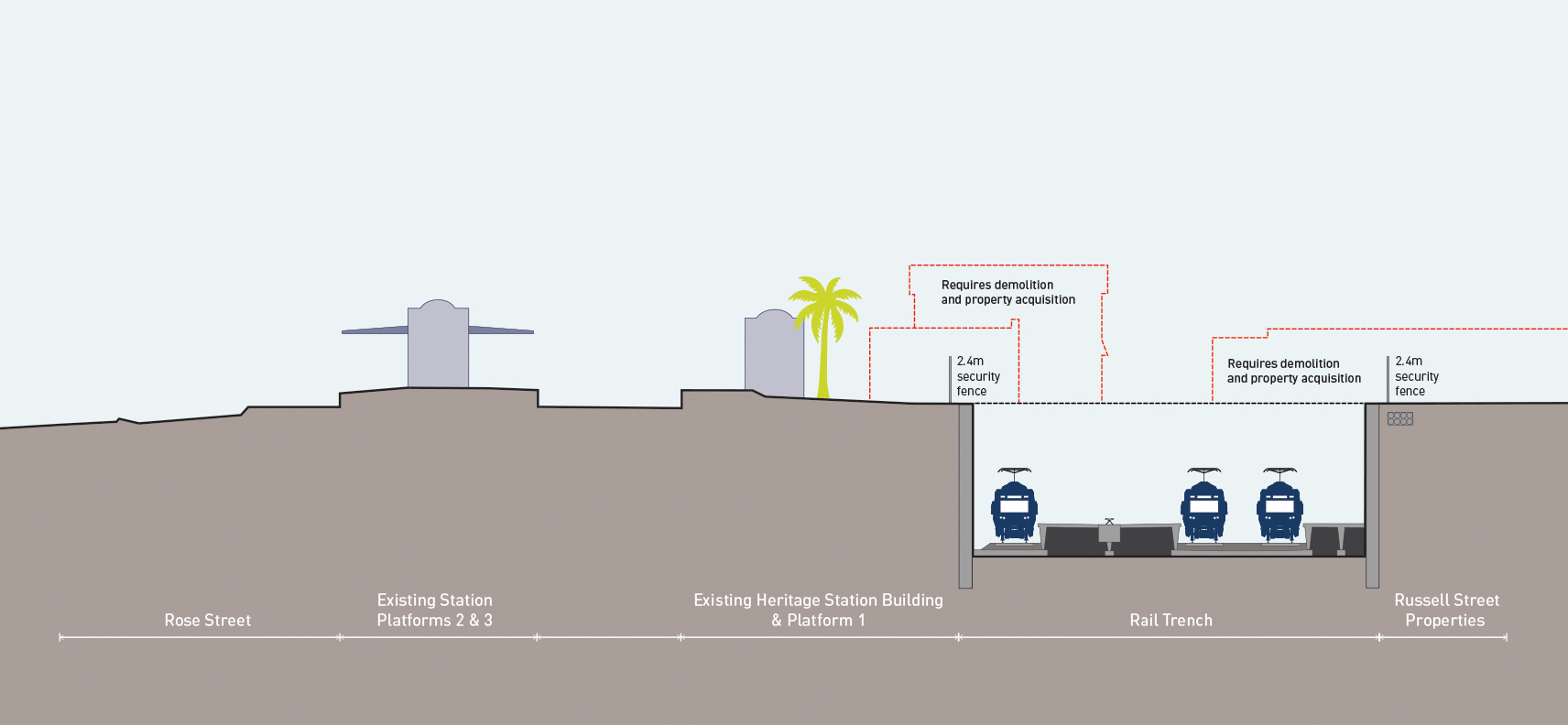
Option 4 (non-preferred option)
Lowering the rail line into a trench, passing under Buckley Street and the existing Rose Street, with Buckley Street remaining at its current level.
Benefits:
- heritage station precinct would remain untouched
- new train station
- retention of Russell Street.
Challenges:
- extensive commercial and residential property acquisition
- trench would divide the activity centre and connections around the broader area
- removes all structures through Rose Street, requiring wholesale redevelopment
- major disruptions to the community via extended construction timeframes to complete works.
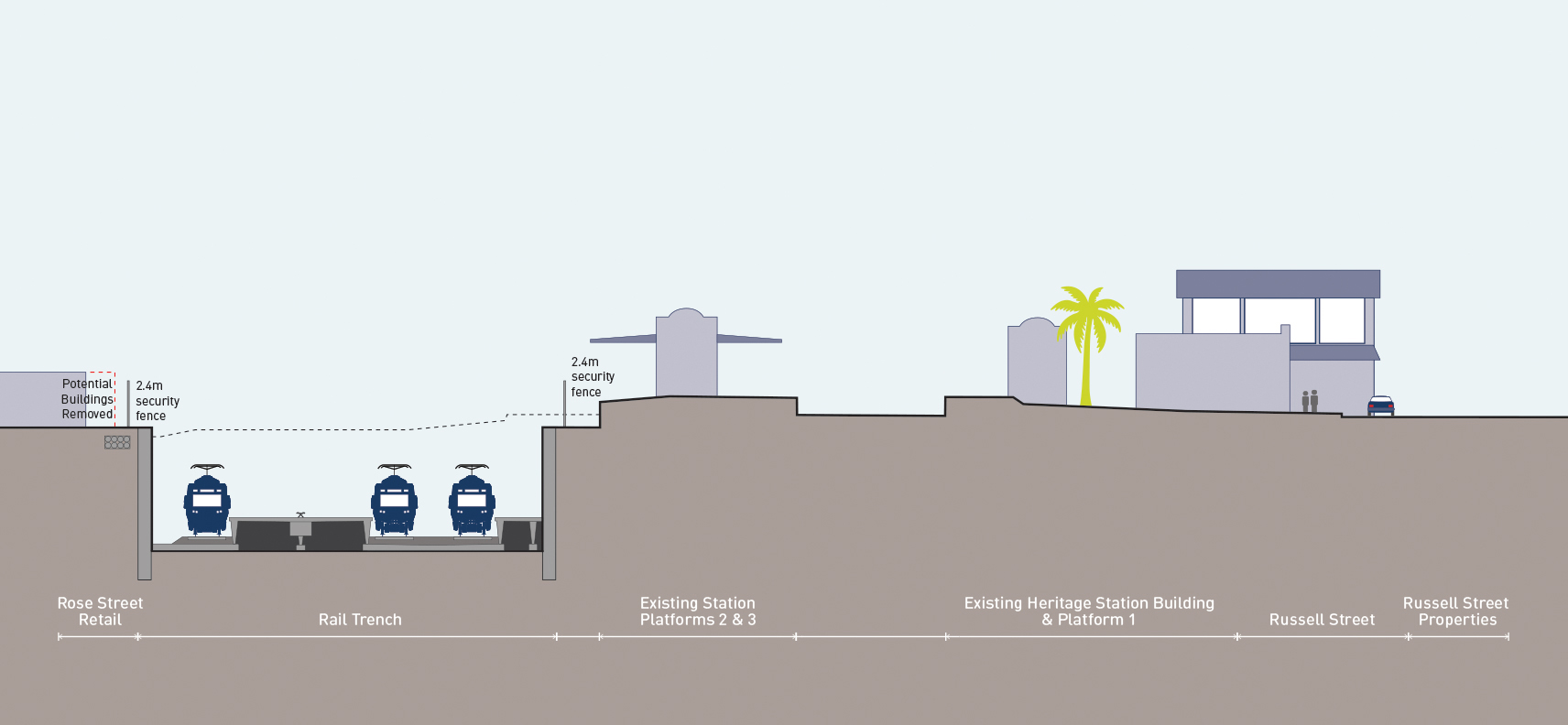
Option 5 (non-preferred option)
Lowering the rail line into a trench under Buckley Street, with the station rebuilt south of its current location.
Benefits:
- heritage station precinct would remain untouched
- potential for re-activation of the heritage station precinct.
Challenges:
- extensive commercial and residential property acquisition required
- significant tree and vegetation removal on Rose Street and Sherbourne Street
- bus and car traffic use along Rose Street would be removed during construction
- Rose Street retail strip would be detrimentally affected and need to be rebuilt.
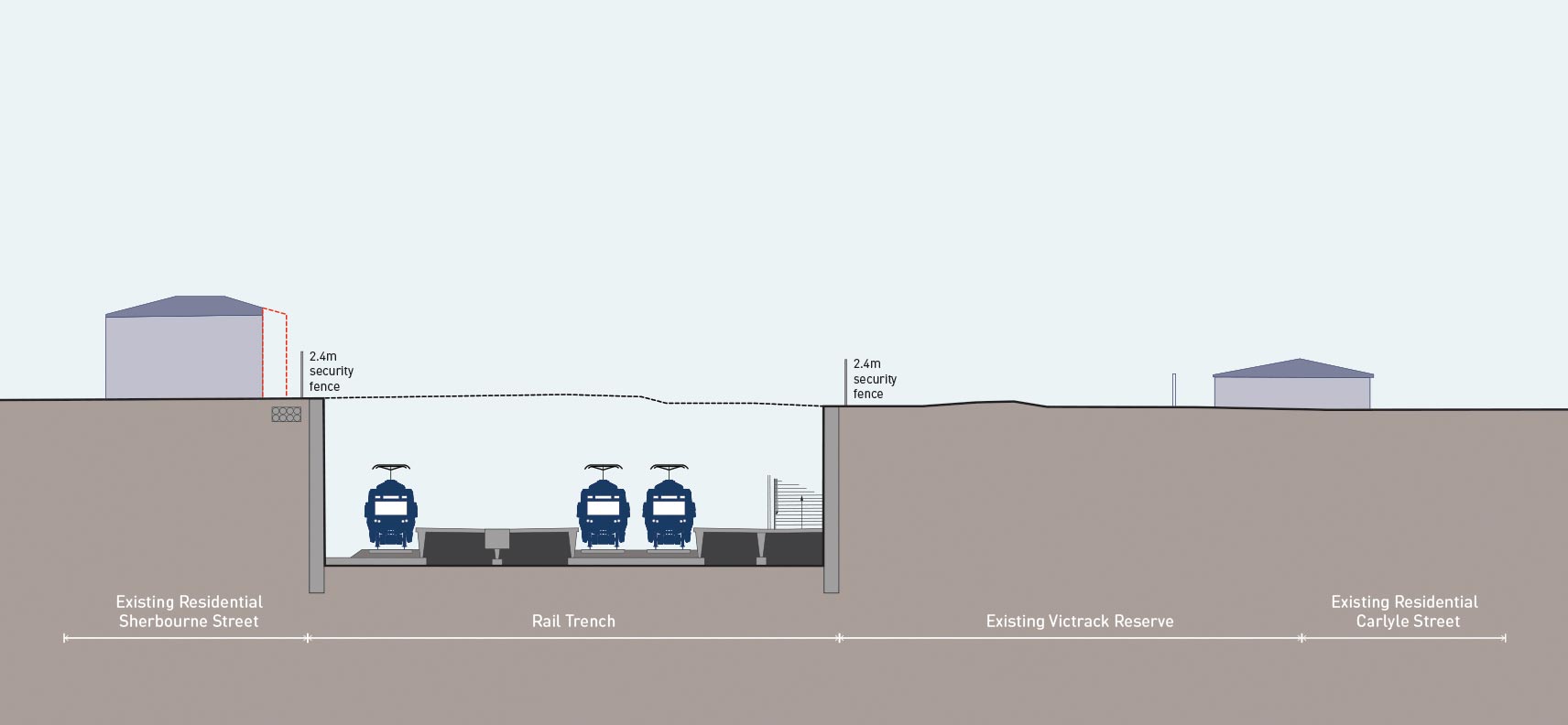
What happens next
| Date | Stage |
|---|---|
| 2016 | Planning
|
|
Late 2016 to Mid 2017 – We are here | Options development
|
| 2017 | Procurement
|
| Late 2017 to 2019 | Delivery
|
Your feedback
Feedback has now closed for this round of engagement about the removal of the Buckley Street level crossing. Thank you to everyone who joined the conversation on our community engagement hub.
The hub is now closed for this phase but you can still view the conversations.